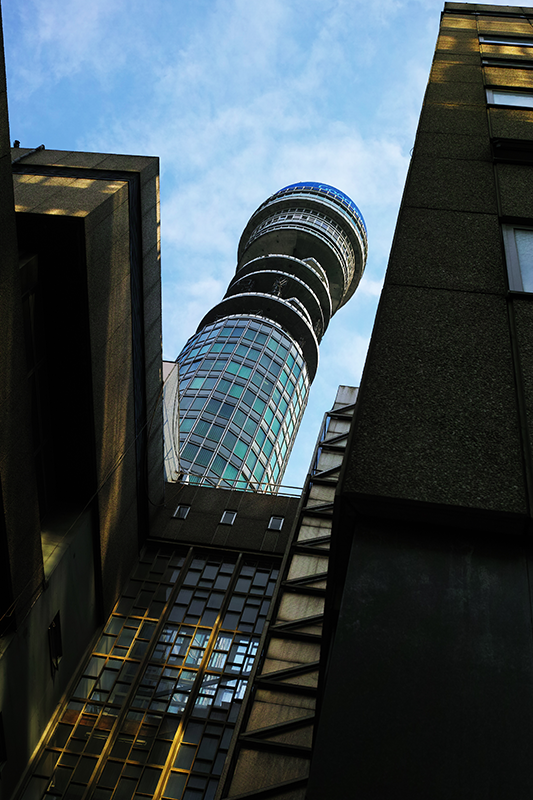The BT Tower in London village it was taken with my Sigma DP2 Merrill I love the Sigma it is my fave digital at the moment. You can view more about the camera HERE. You can also see more of my images taken with the Sigma HERE
What Wikipedia says about the BT Tower :
The BT Tower is a communications tower located in Fitzrovia, London, owned by BT Group. It has been previously known as the GPO Tower, the Post Office Tower and the Telecom Tower. The main structure is 177 metres (581 ft) high, with a further section of aerial rigging bringing the total height to 191 metres (627 ft). It should not be confused with the BT Centre (the global headquarters of BT). Its Post Office code was YTOW.
Upon completion it overtook the Millbank Tower to become the tallest building in both London and the United Kingdom, titles it held until 1980, when it in turn was overtaken by the NatWest Tower.
The tower was commissioned by the General Post Office (GPO). Its primary purpose was to support the microwave aerials then used to carry telecommunications traffic from London to the rest of the country, as part of Britain’s microwave network.
It replaced a much shorter steel lattice tower which had been built on the roof of the neighbouring Museum telephone exchange in the late 1940s to provide a television link between London and Birmingham. The taller structure was required to protect the radio links’ “line of sight” against some of the tall buildings in London then in the planning stage. These links were routed via other GPO microwave stations at Harrow Weald, Bagshot, Kelvedon Hatch and Fairseat, and to places like the London Air Traffic Control Centre at West Drayton.
The tower was designed by the architects of the Ministry of Public Building and Works: the chief architects were Eric Bedford and G. R. Yeats. Typical for its time, the building is concrete clad in glass. The narrow cylindrical shape was chosen because of the requirements of the communications aerials: the building will shift no more than 25 centimetres (10 in) in wind speeds of up to 150 km/h (95 mph). Initially the first 16 floors were for technical equipment and power. Above that was a 35-metre section for the microwave aerials, and above that were six floors of suites, kitchens, technical equipment and finally a cantilevered steel lattice tower. To prevent heat build-up the glass cladding was of a special tint. The construction cost was £2.5 million.
Construction began in June 1961, and owing to the building’s height and its having a tower crane jib across the top virtually throughout the whole construction period, it gradually became a very prominent landmark that could be seen from almost anywhere in London. In August 1963 there was even a question raised in parliament about the crane. Doctor Reginald Bennett MP asked the Minister of Public Building and Works how, when the crane on the top of the new Post Office tower had fulfilled its purpose, he proposed to remove it. Mr Geoffrey Rippon replied, “This is a matter for the contractors. The problem does not have to be solved for about a year but there appears to be no danger of the crane having to be left in situ.”
The tower was topped out on 15 July 1964 and officially opened by the then Prime Minister Harold Wilson on 8 October 1965. The main contractor was Peter Lind & Co Ltd.
The tower was originally designed to be just 111 metres (364 ft), and its foundations are sunk down through 53 metres of London clay and are formed of a concrete raft 27 metres square, a metre thick, reinforced with six layers of cables on top of which sits a reinforced concrete pyramid.
The tower was officially opened to the public on 16 May 1966 by Tony Benn and Billy Butlin. As well as the communications equipment and office space there were viewing galleries, a souvenir shop and a rotating restaurant on the 34th floor, called the Top of the Tower and operated by Butlins. It made one revolution every 22 minutes. An annual race up the stairs of the tower was established and the first race was won by UCL student Alan Green. Tony Benn also designated the tower a mascot of UCL after lobbying by students.[citation needed] Comedian Pat Condell washed dishes in the kitchen for his first job.
A bomb, responsibility for which was at first blamed on the Provisional IRA, exploded in the roof of the men’s toilets at the Top of the restaurant on 31 October 1971. In fact, the bomb had been placed there by members of the Angry Brigade, an anarchist collective. The restaurant was closed to the public for security reasons in 1980, the year in which Butlins’ lease eventually expired.Public access to the building ceased in 1981. The tower is sometimes used for corporate events such as a children’s Christmas party in December, Children in Need, and other special events; even though it is closed the tower retains its revolving floor, providing a full panorama over London and the surrounding area.

